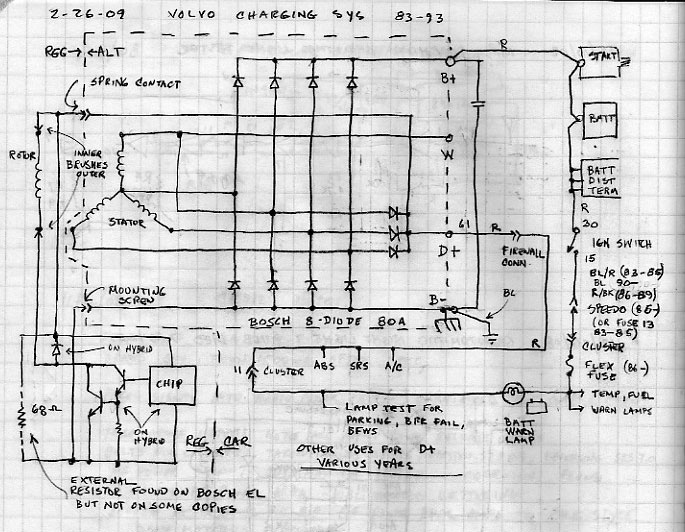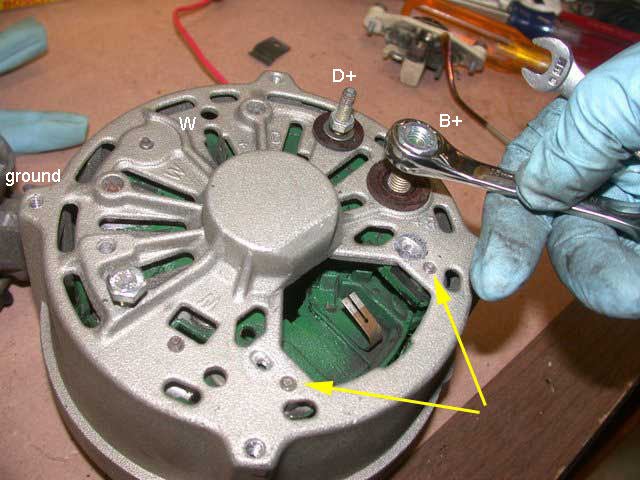|
|
|
Driving down a pretty bumpy road tonight my battery light started flickering just a bit. It continued to flicker very dimly even after I was past the bumpy road. I've got a voltage gauge, and even when the battery light was flickering it read a steady voltage. I've also got a lot of additional lighting on the car, and even with the fan on high and about 350 watts of lighting energized the battery light still only occasionally dimly flickered. So:
1) Is the bumpy road a red herring, am I due for a new alternator?
2) If I do have a faulty alternator should I expect to see some indication of it on my voltage gauge?
3) Is there some obvious possible other point of failure or loose contact that I should be examining, that might trigger the warning light?
Thanks as always for your guidance, brickboard folks.
|
|
|
|
|
A used alternator may be a good choice.
At my salvage yard they had dozens of 740 alternators, because of the abundance of them, I could buy one for $30.
In two of our 740s, the alternators failed at almost 215K miles. A used 110K alternator gave us no problems for 75k miles until we sold the car.
|
|
|
|
|
There is a spec for minimum brush length (extension out of the holder). As I recall it’s 5mm, so 3/16”. For a well worn alternator, anything less than 1/4” is reason for concern. The general guideline is anything below 1/4” and you should start thinking about replacement.
Inspect the slip rings for wear grooves where the brushes ride -slip your finger in. The deeper the grooves, the longer the brush needs to be to make solid contact.
If the alternator bushings/bearings are well worn, on rough road or an otherwise rocking engine can allow the armature to slide back and forth slightly. This makes for momentarily poorer contact when the brushes climb up the sides of the U-shaped wear groove and even with a newer brush/regulator pack can also result in a flickering alt lamp, although a loose D+ wire is an obvious thing to check first. Push/pull on the pulley for movement to check for such wear.
Visually inspect for carbon tracking on the slip rings. Significant carbon buildup can also effect conductivity.
In my student days when money was tighter and for whatever reason the early alts seemingly didn’t last as long as now, people would often solder in new brushes (which were cheap and easy to find) and if the slip rings were in really bad shape I would go so far as to take the alt apart and run it in a drill to polish out the grooves a bit with a fine bastard file and emery cloth to get a bit more life out of it.
If you’ve got a steady dim glow in the alt lamp that you can see in the dark then be suspicious that one of the diodes is failing.
If you suspect the alternator is failing and you’ve still got a starter/alternator shop in your area they can quickly check it out, often for free, and quote you on either rebuilding yours or they may have a rebuilt sitting on the shelf they will sell on a core exchange basis.
Refer to the 700/900 FAQ here for more information on alternator issues
https://www.brickboard.com/FAQ/700-900/ElectricalStarting.htm#AlternatorGettingWeakRegulatorBrushReplacement
--
Dave -still with 940's, prev 740/240/140/120 You'd think I'd have learned by now
|
|

|
|
Could be as simple as a loose D+ spade on the small red wire to the alternator. The battery light stays out as long as the voltage on that D+ wire equals the alternator output voltage as seen at terminal 15 of the ignition switch.
But, the function of D+ to the alternator (through the bulb) is only needed at startup to "pre-excite" the alternator by giving the field winding a little battery voltage. Once it is turning at even idle rpm, the field gets its juice from the three small diodes internal to the alternator.
Brushes, yes, if it flickers irrespective of the road bumps, and you would definitely see that in your lighting if not the voltmeter.
--
Art Benstein near Baltimore
Fifty-one years ago, Herman James, a North Carolina mountain man, was drafted by the Army. On his first day in basic training, the Army issued him a comb. That afternoon the Army barber sheared off all his hair. On his second day, the Army issued Herman a toothbrush. That afternoon the Army dentist yanked seven of his teeth. On the third day, the Army issued him a jock strap. The Army has been looking for Herman for 51 years.
|
|
|
|
|
I had an adjustable voltage regulator on the shelf in the garage, so in it went. Started the car, no dash warning lights. Adjusted the voltage up to ~14.3 volts, still no warning lights. Went for a test drive and the battery light came back on. This time less dim and not flickering, and the parking brake light started coming on too.
Charging voltage is now way down, too, readable on the dash gauge as well as with a meter on the batter 11.75v even at 2500rpm.
No appreciable voltage drop between the alternator casing and the block or the negative battery post. No difference if I jumper the casing to the negative post.
So what does that mean, the alternator itself is on the way out rather than the voltage regulator?
Thanks as always!
|
|

|
|
New voltage regulator and you've completely changed the symptoms. Hmmm.
Go over your work. If you don't find a mistake, suspect the shelved adjustable regulator. I'm not familiar with the adjustable units, but obviously it has a different set of brushes. Put the fixed one back in. Check that D+ wire.
There are four lamps altogether in the cluster that use the D+ terminal to provide lamp test. They are brake failure, parking brake, bulb integrity, and of course, battery. Any difference between the D+ voltage at the red wire going into the large round connector of the cluster and the ignition switch voltage at the L-shaped connector on the back of the speedometer will cause these lights to glow. The battery light comes on first, followed by the other three when the voltage exceeds the voltage drop from the lamp test diodes in the cluster.
Any poor connection along these lines will cause the lights to come on when there is no problem with the alternator and its charging. Usually, that is at the vibration point where the D+ wire plugs on to the alternator, but it could be anywhere inside the cluster or along the wires, such as the flex fuse screw terminals, or the speedometer connector.
If your light is coming on or flickering yet the headlights are steady and the alternator is charging the battery, you don't have a brush problem, you have trouble in this circuit from the D+ terminal through the cluster and to the ignition switch.
Try to put things back the way they were before the alternator quit altogether.

--
Art Benstein near Baltimore
Children seldom misquote you. In fact, they usually repeat word for word what you shouldn't have said.
|
|
|
|
|
Thanks for this take. I had been thinking that increased demand from the higher voltage setting hastened the demise of an already failing alternator, but you're absolutely right that it could just be a faulty voltage regulator. I suspect that one had been on the shelf for~15 years.
I forget to mention it, but I did check both the D+ and B+ connections while swapping out voltage regulators. No visually obvious issues.
As an aside, the bulb has been removed from the bulb integrity warning light and I'm not sure if the same gas been done with the brake failure light, the car is an ABS car. I'll have to see which of those light up at startup.
Unfortunately, or perhaps fortunately, I'm traveling this week and left the 240 (in favor of the wife's 240), since it's apparently protesting. I'll update when I return and dig in a little deeper.
|
|

|
|
No word on the carbon brushes? Guess they're OK, then.
Another seemingly unrelated light coming on can't be good sign. I'd say it's time for the tedious task of checking electrical connections.
|
|
|
|
|
Right, brushes looked ok. Signs of use, of course, but no where near the wear of the ones in your pic.
If I recall correctly, additional light on the dash coming on with charging issues is normal and due to how they ground in the cluster. I'll let someone more knowledgeable than me confirm, though.
|
|

|
|
The alternator light comes on when there's current being drawn from the battery. In case of a running engine, that means that the output from the alternator can't keep up with the demand.
You should see a voltage of around 13.5 - 14.4 V on your voltmeter with the engine running. If it's more like 12 V or less, that's not so good. A coarse meter, like those in cars, probably won't show small fluctuations. The warning light will when it's straddling the line between charge and discharge.
The flickering in conjunction with the bumpy road immediately made me suspect the brushes. It's a simple job to inspect them, almost self explanatory when you see it.
Just disconnect the battery and remove the voltage regulator/carbon brush module from the rear of the alternator.
I bet that one of the two brushes has worn more than the other. This is what I found when mine started to give the same symptoms:

|
|
|
|
|
You are more than likely due for a new brush/regulator pack in the alt, just make sure first that electrical connections are solid and the grounds are good. It’s an easy DIY replacement, maybe wanting to remove the alt the first time so you can see what you’re doing. Just make sure you get the correct one for your alt, not just the year/model as someone may have changed it. Bosch OEM is generally quite trustworthy, but a number of ones are also good. Maybe best to avoid the cheapest jobber brands.
--
Dave -still with 940's, prev 740/240/140/120 You'd think I'd have learned by now
|
|
|
|
|
If your alternator is like those in my 740s, ( a tech once told me that our '88 745 GLE had a 240 engine and would run forever) when the brushes wear short, they can stick or bounce causing problems.
The output that you see may be smoothed out by the regulator and/or by the battery.
I would have a knowledgable person look at your brushes.
Have you read the 700/900 FAQ? - MANY items in this FAQ may well suit your car.
|
|
|
|
|








